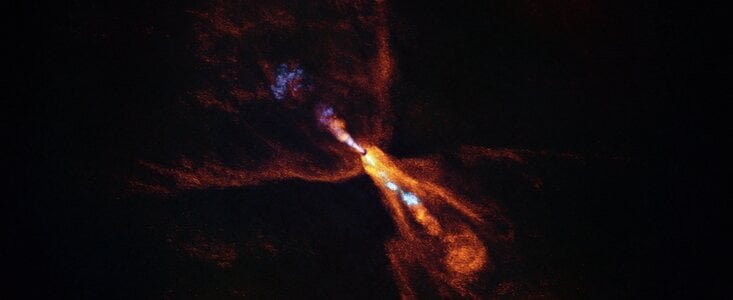
Seeing the Exact Moment When New Planets Started Forming
How did your country report this? Share your view in the comments.
Diverging Reports Breakdown
Seeing the Exact Moment When New Planets Started Forming
Atacama Large Millimeter-submillimeter Array (ALMA) and James Webb Space Telescope (JWST) have seen hot minerals in a distant solar system beginning to solidify to create a small planetesimal. This is the first time astronomers have witnessed a planetary system in the earliest stages of formation. HOPS-315 is a nascent version of our Sun, a G-type yellow dwarf, which means these observations are offering the first clues about what our Solar System may have looked like billions of years ago. In the Solar System, the first material to condense and create bodies is found today in the form of ancient meteorites. As more material accumulated, heavier elements (like iron and nickel) settled into the interior while silicate minerals formed the outer layers. These larger objects grew to become the terrestrial (rocky) planets of the inner Solar System and the cores of the gas/ice giants in the outer Solar System.
Located about 1300 light-years from Earth, this system (HOPS-315) is one of many studied by scientists with ALMA and Webb because of its age and stellar type. Using their advanced radio and infrared optics, these observatories have observed many planet-forming disks around young stars. However, this is the first time astronomers have witnessed a planetary system in the earliest stages of formation. What’s more, HOPS-315 is a nascent version of our Sun, a G-type yellow dwarf, which means these observations are offering the first clues about what our Solar System may have looked like billions of years ago.
The international team responsible for this discovery was led by Melissa K. McClure, an Assistant Professor and Veni Laureate at the Leiden Observatory in the Netherlands. She was joined by researchers from the University of Michigan, Purdue University, the National Tsing Hua University, the Onsala Space Observatory, the Centre National de la Recherche Scientifique (CNRS), and the Southwest Research Institute (SwRI). Their paper, “Refractory solid condensation detected in an embedded protoplanetary disk,” appeared yesterday (July 16th, 2025) in Nature.
In the Solar System, the first material to condense and create bodies is found today in the form of ancient meteorites. Astronomers not only use these rocks to determine when the Solar System began to form, but also to provide insight into the conditions that led to it. For example, these meteorites are largely composed of crystalline minerals containing silicon monoxide (SiO) that can only condense at extremely high temperatures, like those found in protoplanetary disks. Over time, these solids bind together, growing in size and mass to create planetimals that measure in the kilometer range.
As more material accumulated, scientists theorize that heavier elements (like iron and nickel) settled into the interior while silicate minerals formed the outer layers. These larger objects grew to become the terrestrial (rocky) planets of the inner Solar System and the cores of the gas/ice giants in the outer Solar System. As McClure said in an ESO press release: “[W]e’ve always known that the first solid parts of planets, or ‘planetesimals’, must form further back in time, at earlier stages. For the first time, we have identified the earliest moment when planet formation is initiated around a star other than our Sun,” said McClure.
Their results show that SiO is present in these crystalline minerals and around the young star in its gaseous state, suggesting they are just beginning to solidify. The minerals were first identified from spectra obtained by the JWST, while ALMA radio data was used to determine their location in the system. With this combined data, the team confirmed that the SiO signal was coming from a small region in the disk equivalent to the distance between the Main Asteroid Belt and the Sun. This essentially means that this system is an analog for studying early planet formation and how solar systems like our own evolved.
“[W]e’re seeing a system that looks like what our Solar System looked like when it was just beginning to form,” said Merel van ‘t Hoff, an Assistant Professor at Purdue University. “[T]his system is one of the best that we know to actually probe some of the processes that happened in our Solar System.”
Further Reading: ESO
Source: https://www.universetoday.com/articles/seeing-the-exact-moment-when-new-planets-started-forming
